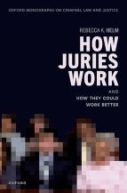How Juries Work and How They Could Work Better
 Author: Rebecca K. Helm
Author: Rebecca K. Helm
Publisher: Oxford University Press, 2024. 240 pages.
Reviewer: Annabelle Frazier | Winter 2025
Juries have long captivated the imagination of both scholars and the public, serving as a focal point for debates about justice, fairness, and community participation in criminal legal systems. Despite this fascination, the actual use of jury trials has markedly declined in recent years, now comprising less than 10% of criminal cases in jurisdictions such as the United States, Canada, the United Kingdom, and Australia. This paradox – waning practical reliance on juries amid growing scholarly and popular interest – sets the stage for Rebecca Helm’s “How Juries Work: And How They Could Work Better.” Helm, a law professor at the University of Exeter, contends that juries remain central to the legitimacy and function of many criminal legal systems, even as their practical role diminishes. Her book offers a timely and compelling re-examination of the jury’s place in modern justice, challenging readers to reconsider both the ideals and realities of jury decision-making.
The book is organized into three parts, each building a nuanced argument about the gap between the theoretical promise of juries and their real-world performance. Helm opens with a global perspective, drawing on wrongful conviction cases to illustrate how jury decisions have shaped – and sometimes undermined – justice. She is careful not to lay blame solely at the feet of jurors but uses these miscarriages of justice to pose probing questions about how juries actually function. Helm’s central thesis is that the gap between juries’ idealized and actual workings has profound consequences for fairness and justice across legal systems. She promises not only to illuminate these discrepancies but also to propose evidence-based reforms that could bring jury practice closer to its democratic and fact-finding ideals.
The early chapters provide a sweeping and engaging account of the historical evolution of juries across different legal systems. Helm traces the increasing demands placed on juries and the gradual reduction of judicial oversight, setting the stage for her broader critique. Her discussion of “Jury Systems Worldwide” is particularly valuable, offering comparative insights into how different countries regulate and manage juries. These chapters highlight the inadequacy of current legal definitions and regulations governing jury roles. Helm distinguishes between the jury’s function as a “scientific fact finder” and its role as a “democratic representative of the community,” arguing that neither is clearly articulated or supported by existing legal standards. She calls for more strategic regulation and precise definitions to ensure that juries can effectively fulfill their intended purposes. For readers in the U.S., these chapters also serve as a valuable introduction to international practices that fundamentally differ from their own- practices about which U.S. scholars and practitioners are often ill-informed.
Transitioning from historical and comparative analysis, the book’s middle section delves into the psychological and empirical foundations of jury decision-making. Helm draws on a wide range of research to examine how jurors interpret evidence, construct narratives, and reach verdicts. She pays particular attention to the influence of juror characteristics, such as attitudes, beliefs, experiences, and demographic factors, on decision outcomes. Helm’s analysis reveals that these factors often shape verdicts in predictable and problematic ways, raising critical normative questions about the fairness and reliability of jury decisions. She critically assesses the extent to which current jury procedures are grounded in tradition rather than empirical evidence. She also identifies systemic weaknesses that can lead to wrongful convictions or failures to convict the guilty.
The middle portion of Helm’s book (Chapters 4–7) delves deeply into theoretical and empirical models of jury decision-making, with a particular emphasis on cognitive processing frameworks. Helm, known for applying “Fuzzy Trace Theory” (FTT), provides a detailed exposition of this model for readers unfamiliar with its premises. FTT posits that people encode information in memory in two forms: gist (the general meaning) and verbatim (precise details). Helm applies FTT to the context of juror decision-making, illustrating how the way information is encoded affects not only what jurors recall but also the meaning they ascribe to evidence during deliberation. Across several chapters, she presents data on juror characteristics, case features, and legal standards, demonstrating how each factor interacts with gist-based processing to produce errors, biases, and misapplications of facts. Helm persuasively argues that the legal system’s reliance on tradition and the expectation that “common sense” will yield just outcomes have led to systemic weaknesses in jury decision-making, which contribute to wrongful convictions and failures to convict the guilty.
However, as I progressed through these chapters, a notable limitation became apparent. While Helm’s analysis of individual juror cognition is thorough, the discussion often shifts from “juries” as collective bodies to “jurors” as individuals. Yet, it is not individual jurors who render verdicts, but the jury as a group. Although Helm acknowledges jury verdicts are a product of collective decision-making, she gives relatively little attention to the group dynamics of deliberation. Evidence from exoneration cases underscores the importance of this distinction: jurors who initially doubt a defendant’s guilt may ultimately vote to convict under the influence of peer pressure, persuasion, or even strongarming during deliberations. Deliberations can also involve content unrelated to the case itself, from ad hominem attacks experienced by holdouts to pressure to “wrap up the case” so jurors can go home. These dynamics may not actually change any individual juror’s interpretation of the evidence but can lead to compliance with the group due to personal, reputational, or social pressures. This suggests that focusing primarily on individual decisions may not fully capture the complexities of how juries reach verdicts. The author accurately notes that far less research has been done on jury decision-making as a group process. I might argue that this is the most significant limitation of existing work on the topic.
Helm addresses this issue more directly in Chapter 8, where she turns to translating individual juror preferences into collective jury verdicts. Here, she proposes an update to the “DISCUSS” model of jury deliberation, aligning it more closely with FTT. Helm critiques the original DISCUSS model for being overly rational, assuming jurors systematically present and discuss information, a notion contradicted by empirical evidence. Indeed, several recent exoneration cases highlight the irrationality of juror thinking (e.g., even including information that was never introduced in court, as seen in Joey Watkins’ wrongful conviction). Her revised, representation-based model better reflects the realities of how information is processed and shared within the group. Nevertheless, this section also reveals another limitation: while the updated model accounts for cognitive processing, it may still underplay the powerful social dynamics and pressures that shape jury deliberations. Overall, Helm’s integration of cognitive theory with legal analysis is a valuable contribution. Still, the book’s primary focus on individual cognition also highlights the need for further research into the collective processes that ultimately determine jury verdicts.
In sum, “How Juries Work” offers a thorough and critical examination of the modern jury, challenging deeply rooted assumptions about how juries function and the extent to which tradition-bound practices serve the goals of justice. By drawing on psychological theory, empirical research, and comparative legal analysis, Helm exposes the many limitations inherent in current jury procedures, ranging from cognitive biases and memory errors at the individual level to systemic issues of group dynamics and representativeness. Notably, she does not merely critique the status quo; instead, Helm presents a spectrum of reform ideas, from incremental procedural adjustments to bold and potentially transformative changes in how juries are structured, selected, and supported. Her work encourages readers to rethink the legitimacy and effectiveness of the jury system, making a compelling case for evidence-based reforms that could enhance both fairness and accuracy. Whether approached by scholars, practitioners, or policymakers, the book serves as both a diagnostic tool and a springboard for future innovation, offering a wealth of insights and practical recommendations that warrant serious consideration and further study.
Annabelle Frazier is an Assistant Professor in the School of Criminal Justice, Forensic Science and Security at the University of Southern Mississippi.


